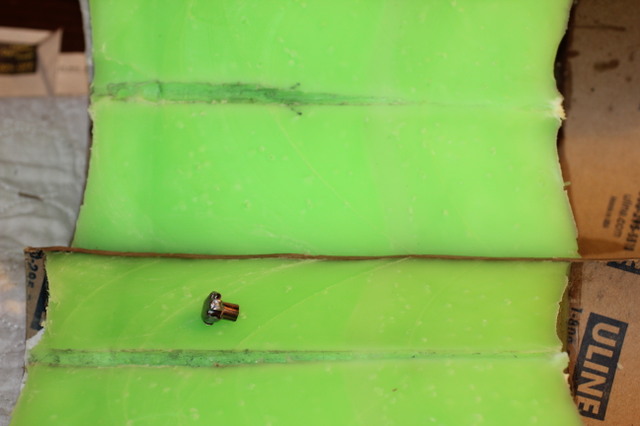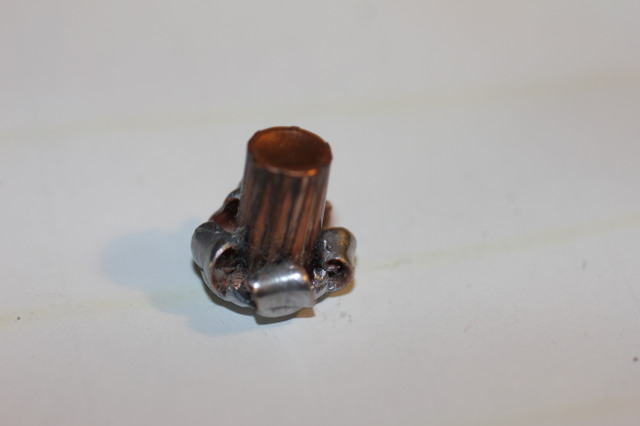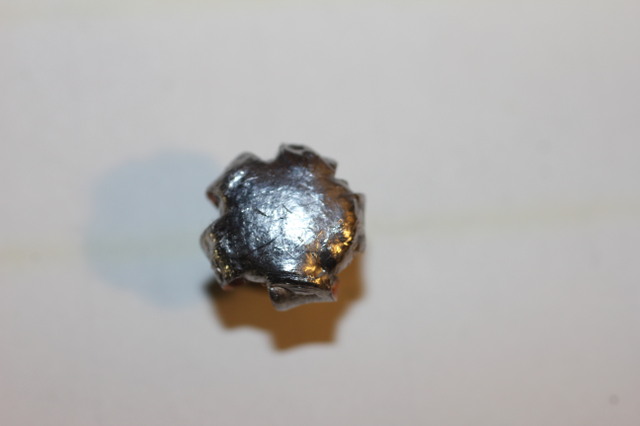
 |
|
|||||||
| Forum Rules | Firearms Safety | Firearms Photos | Links | Library | Lost Password | Email Changes |
| Register | FAQ | Calendar | Today's Posts | Search |
 |
|
|
Thread Tools | Search this Thread |
|
|
#1 |
|
Junior member
Join Date: October 19, 2004
Location: michigan
Posts: 578
|
meplats and does it matter
supposedly meplat creates the permanent wound channel with a cast bullet.
more meplat gives more wound channel and at the same time helping to reduce the bullets tendency to veer off path in target. Yet according to internet, more meplat reduces the total maximum ability to penetrate into the target. SO if i look at internet data and see that the original meplat diameter for the keith swc in 44 magnum was .29-.31 and that i can get a .38 diameter hardcast bulelt with the same meplat diameter , then how can the .357 be inferior due to smaller overall diameter of bullet? |
|
|
|
|
#2 |
|
Senior Member
Join Date: June 6, 1999
Location: El Paso, TX
Posts: 1,021
|
Because you can get a 44 caliber bullet with a far larger meplat than .29-.31 or anything that is possible in a 38 caliber bullet.

__________________
New gun, same ol' shot. |
|
|
|
|
#3 |
|
Senior Member
Join Date: August 10, 2009
Location: SW Idaho
Posts: 1,291
|
I'd like to see some gelatin tests measuring the permanent cavity created by large meplat bullets. I've never seen any.
|
|
|
|
|
#4 | |
|
Senior Member
Join Date: May 20, 2001
Location: Oshkosh wi.
Posts: 3,055
|
Quote:
The way I think of meplat being good at making more severe wounds is the SPLAT factor. It just makes more sense that the wide-flat frontal surface of a semi-wad cutter or round flat bullet will/would make for more side force as it plows through a body. Wounding is all about creating sideways force in tissue. Soft nose and hollow point expanding bullets do it with rapid side force being generated by the peeling back of the nose.
__________________
The more people I meet, the more I love my dog They're going to get their butts kicked over there this election. How come people can't spell and use words correctly? |
|
|
|
|
|
#5 | |
|
Junior member
Join Date: October 4, 2007
Location: All the way to NEBRASKA
Posts: 8,722
|
Quote:
Hint: if you want a really large meplat, get a bullet that expands larger than it's bore diameter- most moder HP SD ammo. |
|
|
|
|
|
#6 |
|
Senior Member
Join Date: February 20, 1999
Location: home on the range; Vermont (Caspian country)
Posts: 14,324
|
I'd ask, first
"What are we trying to do? What is the intended work for our bullet?"
__________________
. "all my ammo is mostly retired factory ammo" |
|
|
|
|
#7 | |
|
Senior Member
Join Date: August 10, 2009
Location: SW Idaho
Posts: 1,291
|
Quote:
"Temporary" Cavities would require a video to observe, but I thought the path of crushed/displaced material was called the permanent cavity. |
|
|
|
|
|
#8 |
|
Senior Member
Join Date: February 7, 2009
Location: Southern Oregon!
Posts: 2,891
|
And you know, of course, everything on the web is true...
I would think the only way a large meplate would limit penetration would be from a large frontal area may slow the bullet more than a needle nose bullet that zips right through. I hear/read of real life accounts of large meplate bullets used for hunting usually are a pass through, complete penetration, anyway...
__________________
My Anchor is holding fast! I've learned how to stand on my own two knees... |
|
|
|
|
#9 |
|
Senior Member
Join Date: April 8, 2000
Posts: 2,101
|
Well I shoot several calibers of WFN type bullets. To date I haven't recovered any of them from critters I have used them on. I wouldn't put to much faith in what your reading unless your looking into hunting hippo's or elephants with a handgun. Even then your probably going to have suggestions to use a WFN loaded to the gills.
As for impact energy, here is a still shot from a video the grandson and I did with my 454 on several 5 gallon buckets of water. The range was 50 yds at impact, velocity at the muzzle was 1550'ish feet per second. The bullet was a Lee 452-300 RF cast from straight wheel weight alloy, The recovered bullet is in the middle here found on the ground after blowing the first two 5 gallon buckets apart, and hitting the third with just enough steam left to push a dimple the size of the expanded nose almost though, but didn't break the plastic. I have shot several nice sized hogs as well as finished off a really nice buck with this bullet, and even plowing through a hog at 87yds I wasn't able to recover the bullet. All of the critters were VERY disrupted on the inside. I shoot these type bullets in my 357, 41, and 44 mags, as well as my 45 Colt and 454. I also have molds for but haven't used them yet in 6.5mm, 7mm, and 30 caliber for my Contenders and rifles. I highly doubt I will have any issues with penetration on most anything I am ever going to hunt in the lower 48. I also can probably count on at least double caliber expansion with most of them as well and possibly even more from the rifles calibers. The penetration and expansion really aren't such a big deal with cast. You will be surprised at just how much damage they CAN cause without expanding and how much can be caused just from the wide flat noses.
__________________
LAter, Mike / TX |
|
|
|
|
#10 |
|
Staff
Join Date: March 11, 2006
Location: Upper US
Posts: 28,813
|
The basic concept is simple, a wide flat nose "hits" harder. Ok, it actually doesn't in terms of energy, but what it does is appear to transfer that energy more effectively.
As far as the wide flat point reducing penetration? ABSOLUTELY. Poke someone with the end of a baseball bat vs an icepick, which one penetrates more? However, as a practical matter, the difference between the large flat point and a pointed or round nose is largely immaterial. Say we make up a scale, giving a nice pointed bullet a value of 100 for penetration. The wide flat point bullet might rate 75. Certainly less the 100. But if complete penetration of the target happens with everything over 40, its a rather moot point. (numbers made up for illustration only)
__________________
All else being equal (and it almost never is) bigger bullets tend to work better. |
|
|
|
|
#11 | |
|
Senior Member
Join Date: December 28, 2006
Posts: 4,342
|
Quote:
|
|
|
|
|
|
#12 |
|
Senior Member
Join Date: August 25, 2008
Location: In the valley above the plain
Posts: 13,424
|
One thing that doesn't get talked about much, but you need to keep in mind about hard cast bullets with a wide meplat, is nose shearing. With a sufficiently hard alloy, the nose of the bullet will shear chunks off as it passes through the target, and effectively turn itself into a conical projectile. While that's happening, the bullet also veers off course. Where it will go, nobody knows...
A good example of wide-meplat-turned-conical can be seen here: RD 432-300 test -Ranch Dog 300 gr .432" bullet, in .444 Marlin, at ~2k fps, into water jugs. Another: the RD 432-350. Although those examples were fired into water and are both Ranch Dog designs, the same thing happens in big game and with other bullets. As a reasonable illustration of why wide meplat bullets are considered to 'hit harder', watch the two videos below. The bullets are of similar weight, nearly identical alloys, and fired at the same velocity; but they have significantly different nose designs. 427 gr FrankenBullet 444 gr Safari Grade In slow motion, you can see the difference. The Safari Grade bullet transfers a lot more energy, and is much more destructive than the FrankenBullet, even though the FrankenBullet is the deepest-penetrating bullet ever tested on that rig, and it still has a 0.200" (46%) meplat. But... both bullets achieved the penetration that they did, because the alloy was not fragile enough to cause any nose shearing, to make the bullet veer off course. (They were fired at 1470 fps for those tests, but both have been tested above 2k fps, with the same results.)
__________________
Don't even try it. It's even worse than the internet would lead you to believe. |
|
|
|
|
#13 | |
|
Senior Member
Join Date: May 20, 2001
Location: Oshkosh wi.
Posts: 3,055
|
Quote:
http://thefiringline.com/forums/showthread.php?t=534023  The permanent wound cavity is the maximum size shown on the left side of the expansion media. Not much bigger than the bullet itself because these were fired at 1800 fps to see if they would expand or not,(as per your question).  
__________________
The more people I meet, the more I love my dog They're going to get their butts kicked over there this election. How come people can't spell and use words correctly? |
|
|
|
|
|
#14 |
|
Senior Member
Join Date: February 20, 1999
Location: home on the range; Vermont (Caspian country)
Posts: 14,324
|
I invite those shooting heavy 45 Colt to investigate the Penn Bullets Thunderhead
__________________
. "all my ammo is mostly retired factory ammo" |
|
|
|
|
#15 |
|
Senior Member
Join Date: August 10, 2009
Location: SW Idaho
Posts: 1,291
|
Snuffy - sorry, but your description of "permanent cavity" seems more like "temporary cavity". I spent a little time Googling the subject.
Regardless of the testing media used, permanent cavity is simply the crushed & displaced material along the bullet path. Most sources agree that this is the primary killing mechanism. Bullet meplat diameter affects the permanent cavity to some extent and testing media matters only when we try to extrapolate the results to actual flesh. What I've always wanted to see is an honest gellatin test of WFN hardcast handgun bullets, where somebody actually measured the permanent cavity and then compared it to something like a round nose bullet of same caliber. |
|
|
|
|
#16 | |
|
Senior Member
Join Date: February 7, 2009
Location: Southern Oregon!
Posts: 2,891
|
Quote:
__________________
My Anchor is holding fast! I've learned how to stand on my own two knees... |
|
|
|
|
|
#17 | |
|
Senior Member
Join Date: August 4, 2005
Posts: 2,017
|
Quote:
Several things need to be remembered. First is MASS x VELOCITY = ENERGY. Have a little glance at the difference in average bullet weight and the velocities they are being driven at for the .357 and .44 Mag you're trying to compare. You're going to be hard pressed to find a .357 bullet load anywhere that can deliver as much energy as a .44 Mag can. Then you have to figure in not only nose design of the bullet but the alloy it is constructed of. That determines HOW the potential energy is being transferred to the target after impact has occurred. I suggest instead of web surfing, do some actual tests for yourself. Those will show you what differences exist and why.
__________________
"Why is is called Common Sense when it seems so few actually possess it?" Guns only have two enemies: Rust and Politicians. |
|
|
|
|
|
#18 |
|
Senior Member
Join Date: February 20, 1999
Location: home on the range; Vermont (Caspian country)
Posts: 14,324
|
....except energy doesn't matter....
__________________
. "all my ammo is mostly retired factory ammo" |
|
|
 |
|
|